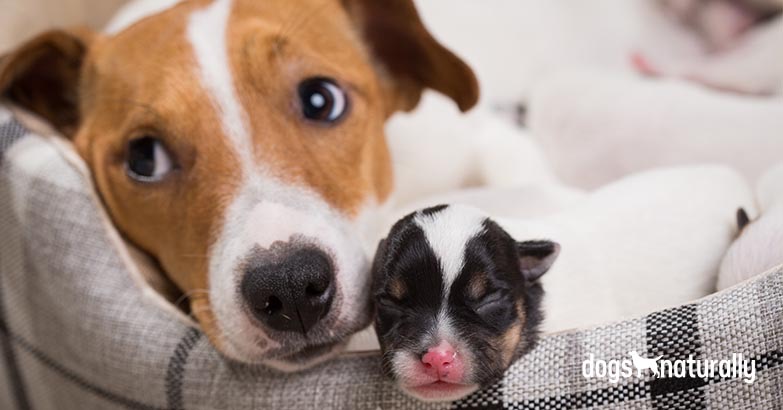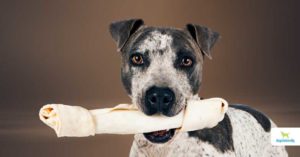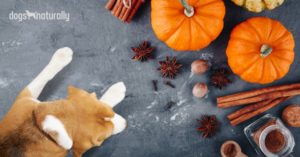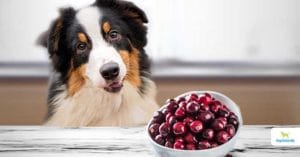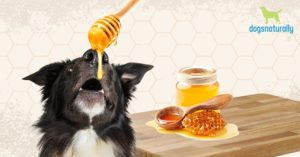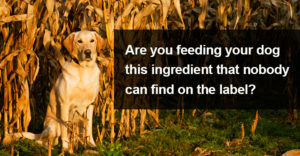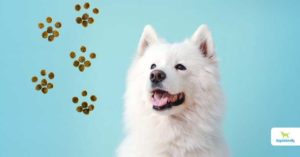Making sure that your dog is well nourished is always the job of a dog owner. But when your dog is going into heat, pregnant, or just had puppies, it’s even more important!
I’ve put together this guide that will help you keep your dog happy and filled with the foods she’ll need during these special times.
Nourishing Your Dog In Heat
Estrus or heat is the stage in a female dog’s reproductive cycle when she’s receptive to mating with males. Estrogen levels increase and then sharply drop once heat is over.
Heat lasts around 3 weeks (although this varies) and is usually twice a year. During this time, your female dog goes through many changes. That’s why I recommend feeding a slightly modified diet to support her when she’s in heat.
Human females go through different dietary needs during their monthly cycle. And so do female dogs when they’re in heat. I’ve observed this with my 12 female Chihuahuas, known as the Queeniechi Gang.
Mood Changes
I’ve noticed that when the girls start to come into heat, they’re often a little cranky with the other dogs in the household. This is usually a few days before the bleed starts. Nothing dramatic, just a little off. This made me think about the female pain threshold.
Dogs tend to be stoic about pain, so why would heat, especially the cuddly (bleeding) part of heat, be any different? This has led to lots of observational research on my part. So I watch the interactions between female and female as well as female and male:
- Are the older females more tolerant, accepting, and understanding?
- Are the younger females oblivious?
- Or do they stay out of the way of the female who’s about to come into heat?
- Do the males get interested far too early?
Living in a multiple dog household has its challenges!
My dogs are not for breeding. So managing to avoid pregnancies has become a mission in itself. It’s a rhythm my entire family, both human and pet, has come to accept.
It’s fascinating to watch and study. I keep lots of spreadsheets to record their interactions. And I note how they vary when I give them different foods. So, while it’s not academic research … there is some science to back up my methods.
RELATED: Diet, brain health and behavior in dogs …
Food Makes A Difference
Here’s a story for you: I was asked to do a consultation for a female intact 9-year-old dog. The dog had terrible scratching and itching! She was eating a fresh raw diet and her owner was at her wits’ end.
This case wasn’t quite what it at first seemed. It turned out that every time this itchy female went into heat … she was being viciously attacked by the other intact female.
I decided to modify the diet of the itchy female a week before the cuddly stage was about to begin. Later on, getting this timing right became a fine art. Without testing, it can be hard to tell exactly when the heat is starting. The itchy dog’s owner paid close attention to minor changes in her behavior.
I formulated a diet that was different for the non-itchy female. When the cuddly stage started there were no fights for the first time. And this has continued. Both females now get the same diet each time either of them is coming into heat. No more itching, no more fighting. I’ve seen this many, many times over.
I bet you’re sitting there thinking, okay … but how does this work?
Matching Food To Your Dog’s Needs
When we experience blood loss, we get hungry and thirsty … and so do dogs. Some dogs are incredibly sensitive to the amount of blood they lose. I know the number of daily calories my dogs need. I work out the calories for that week. Then I feed accordingly.
Some days they’ll eat fewer calories because they lie around a lot and don’t do much. I might even skip a meal, or feed a lighter diet that day because they just haven’t used much energy and don’t feel hungry.
On days when they’ve been incredibly active and their minds are busy, I feed them more. They get more calories and they may eat more often. This usually means two main meals and a few snacks along the way. At the end of the week, the calories will balance out. You can also do this if you’re feeding by percentage of body weight.
During heat, there’s:
- Blood loss
- Increased hunger
- Cravings
- Pain
- Hormonal changes
- Mood swings
- Fatigue
- Generally feeling out of kilter
Toileting may also be disturbed. There may be changes in the frequency and consistency of the stools. And sometimes more frequent urination.
Satisfy Your Dog’s Hunger
Satisfying your dog’s hunger is ever more important during the beginning stages of heat. I nourish my female dogs with foods that help satiate them at the cuddly stage. Food that gives them that Sunday pot roast feeling!
Think of that feeling on your day off work when it’s a feast day! You eat well, take your time eating … and then take time to be the “lion” after the kill. You rest and snooze, feeling content and relaxed. Some dogs never get to experience this strong sense that all is well.
Why does this happen? Because we completely control our dogs’ meals … how often and how much they eat. So my method has even more impact on a female in heat.
At the cuddly stage, I add up to 20% more food to my dog’s usual diet. And I add foods that help her feel satiated and fuller for longer. This releases happy hormones into her bloodstream. They help her feel more relaxed and pain-free. And she recovers from blood loss quicker.
The Need For Fiber
I don’t generally recommend feeding more than 15% vegetables a day. But at this time a small increase is fine. This is just a guideline, as all dogs are individuals. You’ll need to find the magic number for your own dog.
Root vegetables tend to contain more fiber than above-ground vegetables. I give them when I feed this way. I believe fiber is an essential component in a dog’s daily nourishment. This is never more true than at the cuddly stage of heat!
Fiber helps deliver good levels of hydration through the food. If you’ve ever switched your dog from kibble to raw, you’ll have noticed the dramatic drop in the amount of water she drinks.
If You Feed Kibble: Dogs need a good 70% moisture in their diets. That’s impossible to calculate when feeding kibble alone. So if you must feed kibble, how about switching to whole food meals twice a year when your dog’s in heat? It could be the start of something beautiful for you and your beloved dog!
Filling Foods
So what satiating foods should you feed – and how?
Here’s what I do. I add a little gently steamed parsnip and some grated steamed sweet potato to my females’ meals. Other good options are:
- Celeriac
- Fennel
- Winter squash
- Green cabbage
- Zucchini
- Beets (fresh, skin on)
- Cauliflower
- Sugar snap beans
- Turnips
All these veggies are steamed for digestibility.
I also offer papaya and apple.
Papaya’s delicate fibrous flesh offers a gentle-on-the-tummy way to deliver a fresh and much-needed dose of vitamin C. This helps with recovery and repair.
Sweet apples contain pectin (a polysaccharide that helps plants maintain their upright position). Pectin can help control blood sugar levels. She’ll also pee less from inflammation or pressure when the bleed starts.
RELATED: Can my dog eat apples? Benefits of feeding them to your dog …
You Can Experiment!
I’ve tested these fruits and vegetables on my females for the past 10 years or so. There may be more to discover! Let your imagination run free. Perhaps drop me a line to let me know of any new veggies that you’ve discovered for your dog?
These foods all help your female in heat feel fuller for longer, and she’ll feel calmer. The natural sugar in the fruit can also be good for her when she’s losing blood.
Sugar has become such a dirty word these days. But sometimes the body needs it and you crave it. Dogs are no different, especially at a time of extra stress on the body. The low natural sugars in the extra serving of veggies or fruit won’t cause any health problems.
So what about the humpy stage? And won’t my dog put on weight eating this extra food?
Nope! Because your female is feeling more active, more social, more frisky … with a fabulous sense of wellbeing! Watch her swish that tail (flagging) and strut her stuff!
When the cuddly stage phases out and the humpy stage takes over, that’s the time to reduce her overall food intake. If you increased her food by 20%, now reduce it by the same amount.
This way of nourishing females during heat has worked very well for me and the Queeniechi Gang … and many others who’ve tried the method. I’ve named this The Rutherford Cuddly and Humpy Method!
Now … what if your dog’s pregnant? Let’s get into some detail on that.
Feeding Your Pregnant Dog!
Dogs are pregnant on average for 63 days (9 weeks).
First, before your dog becomes pregnant, I recommend you get her a checkup with your vet. Ask for a basic blood panel, so you know she’s in good health before starting. She should be fit, at a good weight and eating a raw, fresh diet.
Responsible breeding means you know your dog is pregnant. And you’ll also know the date she’s due to give birth. While she’s pregnant, she’ll have some special food needs. Once a dog is pregnant, I add some extras to her diet to support the growing litter inside her.
I like to break the 9 weeks of pregnancy into 3-week trimesters.
1st Trimester
Feeding in the first trimester takes careful handling. Your beloved dog can seem perfectly fine and not affected by the miracle that’s inside her at all! It’s a very important time. And often her extra nutrient requirements don’t seem obvious. This is a time when your dog may get constipated due to the flood of new hormones racing around her body.
I like to add around 10% more green leafy veggies to her diet in this trimester (steamed or puréed for digestibility):
- Spinach
- Swiss chard
- Green cabbage
- Broccoli and other greens
These are all good choices to add fresh source of vitamins and fiber.
Newly pregnant females often feel nauseous in the first trimester. Your dog may have what appears to be hunger pukes or all-day sickness. I always recommend breaking the fast first thing in the morning with lighter food … instead of a heavy meal as her first food of the day.
Breaking The Fast
Breaking the fast is about feeding a very small amount of food to wake up the gut bacteria. Feed it at room temperature as soon as your dog wakes up. Then wait at least 45 mins before the main meal of the day (if you feed in the mornings). Breaking the fast this way soothes the stomach.
Breaking the fast can include foods like:
- Raw or canned (in spring water) sardines, jam-packed with super healthy omega-3s
- A spoonful of kefir to keep that gut bacteria happy
- A teaspoon of raw honey or full fat cottage cheese for energy
- Dry-fried, sliced shiitake mushrooms for vitamins D2 and immune boosting beta glucans (see below)
- A teaspoon of nut butter for vitamin E and all-important fiber to keep things regular
- Tahini (sesame butter) is another great little energy booster at this stage
Caution: Some dogs are lactose-intolerant. So only give kefir if your dog tolerates dairy.
And make sure your nut butter is free of xylitol and sugar. The best way to be sure of that is to make your own nut butter recipe.
Homemade Nut Butter Recipe
Trust me, it’s delicious (of course you can eat it too)! Keep it in the fridge for up to 4 weeks.
PRO TIP
I roll my loose nut butter mixture into a sausage shape, then wrap it in unbleached parchment, and freeze it. When I need some, I just slice a disc off. It’ll keep well in the freezer for up to three months. Always avoid macadamia nuts; they’re poisonous to dogs.
Feeding Mushrooms
Always cook mushrooms for your dog. Raw mushrooms are indigestible.
- Pop them sliced into a frying pan preheated to a medium heat.
- Cook them for around 6 minutes until they become soft.
- Add a little water if they start to stick (this usually means your pan is far too hot, so turn the heat down too).
The moisture from the mushrooms will cook out; there’s no need for any oil. Once cooled, you can store the mushrooms in a glass airtight jar in the fridge for up to 2 weeks. Or you can freeze them for a month.
Mushrooms are like little sponges and will absorb any fluid they’re paired with. Shiitake and portobello mushrooms are in most supermarkets these days. Buy organic mushrooms that have been grown in natural light if you can.
Caution: Never allow your dog to eat mushrooms that are growing freely in your garden or on a walk … unless you’re certain of the species.
RELATED: Worried about kennel cough? Mushrooms can help …
2nd Trimester
Pregnant female dogs gain approximately 15 to 20% more weight depending on the size of the litter. Continue the 1st trimester feeding routine. Increase green leafy veggies and break the fast every morning. I don’t advise giving extra calcium during the pregnancy as it can lead to overcalcification in the fetus.
Keep your dog in good condition with plenty of walks. But let her decide when she’s had enough. At this point in the pregnancy, she should be feeling pretty good and be able to pretty much function as normal. She’ll be thirstier than usual and will need to pee more often.
Here, I would take note of her favorite foods. You can prepare and store or freeze some of them for the third trimester. This is a good time to prepare a batch of bone broth for the freezer. It’s nourishing and easy to digest.
It’s very important to feed your pregnant dog between 60 and 70% good quality protein. A fresh, raw food diet is optimal.
3rd Trimester
This is the tricky stage! Your mum-to-be often becomes a picky fusspot! Maybe even a fully-fledged diva when it comes to food. It’s tricky because she can’t tell you what she wants to eat, so you don’t know if she’s craving something special. This is why finding out your mum-to-be’s food preferences in the second trimester is so important.
You may need to throw the idea of feeding a balanced diet out of the window at this point. Allow mum-to-be to guide you in exactly what to feed.
It’s a healthy form of food self-selection. You’re giving your pregnant dog some control over what she eats. Avoid getting desperate and feeding processed foods like ham … though a little to encourage her to eat won’t hurt.
There will inevitably some frustration for you both over food at this point. You’ll need to strike a delicate balance of feeding enough but not over-feeding. An obese pregnant dog is not what you want to end up with.
The puppies are rapidly growing at this stage. This puts the most stress on your mum-to-be. Her heart, lungs and kidneys will be working overtime. Her joints may ache from the extra weight. She may get acid reflux.
Now’s the time to start reducing the size of each meal … but increase feeding frequency. Four meals per day will keep mum-to-be topped up with fuel. As the puppies grow, space runs out. She’ll be very hungry but just can’t fit the food in! So smaller, more frequent meals are the key.
Flash-frying a juicy piece of meat may encourage her to eat.
- Add a knob of goat butter to a hot skillet
- Once it melts add your room temperature meat to the pan
- Cook on each side for a couple of minutes (use your judgment, larger pieces need more cooking)
- Don’t cook the meat straight from the fridge, or it will get super tough when cooked. Allow the meat to rest for a few minutes before serving
PRO TIP
Add any leftover juices back to the pan (off the heat) with a little more goat butter. The residual heat will melt the butter. Allow the juices and butter to cool down.
Put the juices and melted goat butter into a small spray bottle and keep in the fridge for two weeks or freeze it. This will create an appetizer spray to use later if mum-to-be gets too picky. You can spritz it on the food to encourage her to eat.
Often as the birth gets close, your mum-to-be will go off her food. This is a sign to get ready for the big event. Good luck and have fun with the new babies!
Feeding Mum After Birth
Feeding your beautiful mum after the birth of her pups can be a tricky affair if she’s starving hungry. But you’re not sure what her body needs to nourish the pups!
During the birth period, your dog may not eat for 24 hours before the birth. I feel it’s important to offer something small and nutritious during birth … in between pups, to give your mother-to-be some energy. Even if it’s a rub of some Manuka honey on her gums … this will help. Small amounts of anything tasty and nutritious will be welcome.
Try A Light Stew
After the birth, I’d suggest offering a lightly cooked nutritious stew. I find something light but fairly bland works well. I recommend adding to a pan some chopped turkey rich in tryptophan to keep your new mum relaxed and calm.
Ingredients
- Chopped turkey
- Sliced fennel
- Sliced zucchini
- 1 egg
Turkey is a lean meat that’s light on the tummy and full of flavor. I prefer it to chicken.The fennel will help settle her tummy.
Directions
- Pop all the ingredients except the egg into a pan.
- Add 1⁄2 cup of water to stop the meat from sticking.
- Cover with a lid and leave on medium heat for around 8 minutes.
- Now add the egg and mix it through.
- Lastly, add a pinch of natural salt (Pink Himalayan is my favorite) and a two-inch block of goat’s butter. The goat’s butter is to provide some fat for energy.
Serve this warm to your dog 4-5 times per day. If your new mum is refusing to eat, then I recommend hand feeding her for a few days. She could be feeling a little overwhelmed and reluctant to move away from her puppies.
The Next Phase
Feed her this way for 2 or 3 days then switch back to her normal raw food. Make certain your new mum is getting plenty of calcium. When she’s feeding a litter, her body is using its calcium stores to help make her milk.
I tend to stay away from organ meats for a few days. Your new mum’s tummy can be fairly sensitive … and if she’s eaten the placentas then this is not the time to add offal.
Your new mum’s first poop is often green in color if she’s eaten the placentas. So don’t be alarmed! Eating the placentas is perfectly natural. But if there are a lot of pups, I’d limit the number she eats. It could upset her tummy.
At this point, make sure your new mum has a varied and balanced diet. Balancing food over time is fine when your dog’s fit and well. But when your dog has had puppies she needs the correct nutrient ratios.
If you’re not sure about this yourself, find a professional to create a balanced meal plan. Or you can buy a trusted pre-made raw that’s complete and balanced. Adding some extras like eggs or canned sardines is a great idea!
Extra Calcium
Feed mum at least 3 times a day for the first 2 weeks. Increase the amount of food she normally eats. It’s a good idea to add extra calcium to her diet to make sure she doesn’t get eclampsia (also known as milk fever). This often happens around 4 weeks, 5 days.
A word about your source of calcium …
I prefer feeding raw bones or bonemeal for calcium. I don’t feel that feeding crushed eggshells is enough calcium. Dogs don’t absorb calcium carbonate very effectively. But you need to make certain that your new mum doesn’t get constipated with too much bone. So make sure you give her plenty of fiber.
Some fresh steamed veggies tossed in olive oil make a delicious addition. You can also include some lovely fresh or canned sardines as an afternoon snack. The vitamin D will help her absorb calcium.
RELATED: How to balance the calcium and phosphorus in a raw diet for dogs …
It’s Weaning Time!
Now … this is the fun part!
When the puppies are ready to be weaned at around 4 weeks old, they can join in meals with their mum.. I suggest feeding a previously frozen raw ground beef or turkey to the puppies. (Freezing helps eliminate parasites.) I don’t feel it’s necessary to wean pups onto a special paste.
Make certain that the ground meat is properly defrosted. Serve it at room temperature on a flat plate and let the pups start eating.
Puppies start to get their teeth in at 4 weeks, so they can cope with soft room temperature mince easily!
Just watch them dive in!
PRO TIP
Try putting a large towel underneath the plate. It’ll help the pups gain a bit of traction to get to the plate on their unsteady legs. It also helps to contain the mess.
Your new mum will clean all the pups up and probably try to eat all of the food. Make sure that the pups are never unattended when they’re fed. There’s no need to worry about balance and calcium at this stage as the pups will still be feeding on their mum.
Once the puppies have the hang of solid food, switch to a premade complete food. Encourage the pups to wean away from their mother’s milk when you feel the time has come. Mum will let them know … especially when they nip her with their sharp little teeth when feeding!
It’s without a doubt the very best start in life to be weaned on to a fresh, raw diet from the beginning. Your puppies were designed to eat this type of food; watch them thrive on it!
And in a few weeks, they’ll be ready to start eating a balanced diet of their own.

